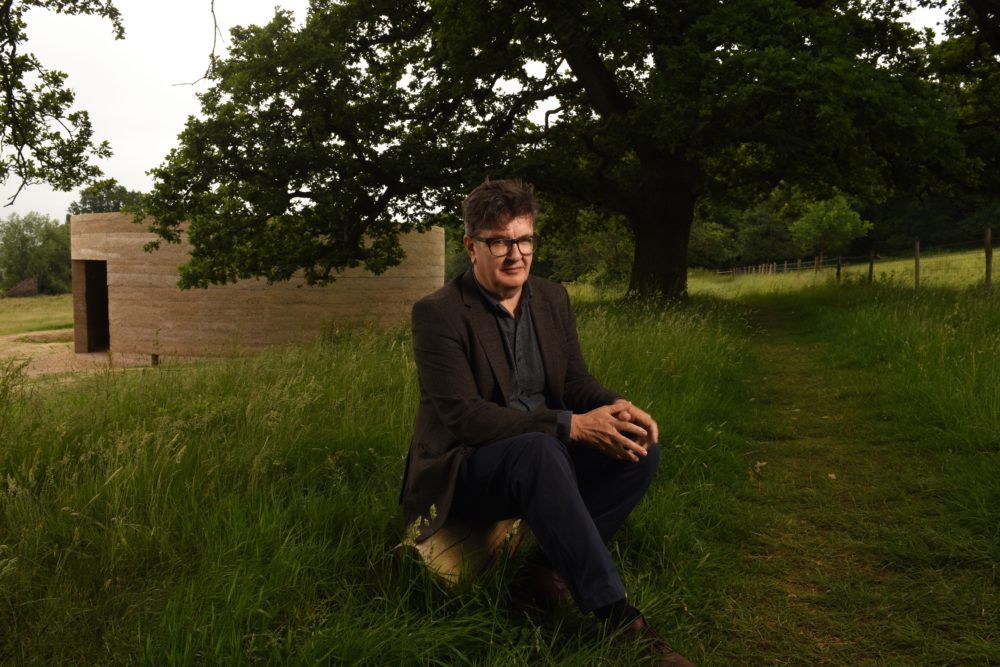
The British artist Mark Wallinger has unveiled a public artwork at Runnymede, where King John was forced by his uppity barons to put his seal on the Magna Carta more than 800 years ago.
In a meadow next to the river Thames in Surrey, west of London, the new work commemorates the 39th clause of that great charter of liberties, which enshrines the right to a fair trial. At a moment when the treatment of detainees, refugees, and immigrants is dominating conversations across the globe, the work, called Writ in Water, takes on added meaning.
“Magna Carta was the beginning of common law, and the idea of the right to trial by your peers, which led to trial by jury, and everything that flowed from that, from the rights of man all the way through to the declaration of human rights after World War II, which was the first codification of universal rights,” Wallinger, the winner of the 2007 Turner Prize, explains to artnet News.
Wallinger’s sandy-colored structure, which was unveiled officially on June 16—the 803rd anniversary of the historic sealing—can be reached by a short pilgrimage through long grass and British wildflowers cared for by the British conservation charity National Trust, which commissioned the work with the public arts organization Situations.
Along the way, visitors pass other tributes to the historic site, including Hew Locke’s The Jurors, a sculpture of 12 bronze chairs engraved with imagery addressing global struggles for freedom, rule of law, and equal rights; the American Bar Association’s Magna Carta monument; and memorials to JFK and the Allied Air Forces of World War II.
The exterior of Writ in Water. Photo by Andrew Butler, courtesy National Trust Images.
Conceived with the London-based firm Studio Octopi, Wallinger’s architectural landmark gives off the mystic vibes of ancient sites such as Newgrange in Ireland, or Stonehenge. Built using the medieval measurement of cubits—which is roughly the distance between the tip of your index finger and the crook of your elbow—the structure is made from rammed earth and sand quarried locally. It contains, by way of a simple labyrinth, an inner chamber centered around a pool of water into which Clause 39 is reflected from writing inscribed along its edge.
The clause, translated from Latin, asserts that:
“No free man shall be seized or imprisoned, or stripped of his rights or possessions, or outlawed or exiled, or deprived of his standing in any way, nor will we proceed with force against him, or send others to do so, except by the lawful judgment of his equals or by the law of the land.”
The interior of Writ in Water. Photo by Andrew Butler, courtesy National Trust Images.
Since its establishment, the charter has become an important part of global political life and underpins many fundamental civil liberties. The message of Clause 39, in particular, is enshrined in the fifth amendment to the US constitution. The United Kingdom, however, has no such written constitution and so, as the title of the work asserts, these rights are “writ in water” rather than formally set in stone.
Wallinger says the title comes from the poet John Keats, who didn’t think anyone would remember him when he died at 25 years old in 1821, and so had his epitaph read: “Here lies one whose name was writ in water.” The words of Magna Carta, like Keats’ poetry, must be repeated generation after generation if they are to be preserved.
“I still think it’s incredibly important,” Wallinger explains. “We take for granted certain rights that can quite easily be eroded or swept away by despots or by neglect, and the easy solutions of populism and fundamentalism.”
The interior of Writ in Water. Photo by Andrew Butler, courtesy National Trust Images.
Wallinger says that the law enshrined in his artwork represents generations of people struggling for their rights—freedoms that are constantly under threat.
“I hope that people will think about this sentence that still resonates,” Wallinger says. “Eight hundred years is a long time, and people live in a more immediate, unhistorical reality, and are apt to forget the various struggles that have got us to where we are in the intervening years.”
Writ in Water opened permanently to the public at Runnymede, Surrey, on Saturday June 16.